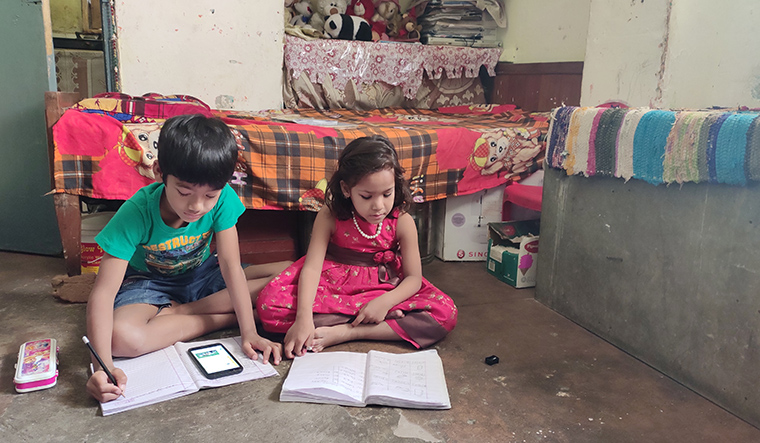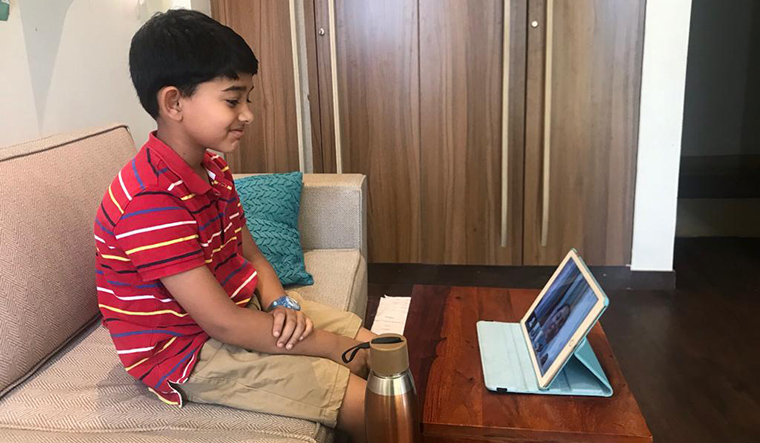Every day, fourth-grader Himanshu Aryal and his second-grader sister Kanishka wake up early, bathe, breakfast and get ready for school, which begins at nine. Their classrooms these days are WhatsApp groups their teachers created. Over the next few hours, the siblings, who study in a New Delhi Municipal Council-run school, take turns with the lone smartphone in the family. They listen to the five-minute audio clips from their teachers about a new lesson. They look at the screenshots of pages from the textbook and take down instructions for the assignments, which range from learning spellings, solving sums and a lot of self-expression through essays and artwork. Kanishka’s day was made when her teacher gave her a “Good” on the group. She ensures that she does not miss a single lesson.
The Covid-19 pandemic had forced schools to close even before the nationwide lockdown; the academic year was curtailed and students were promoted without final examinations. The new academic session began on April 7, and schools made students report to virtual classrooms.
This experience is as novel as everything around us right now. Nursery school teacher Shalini Jain said it was for the first time that an entire batch of children had begun school life over videoconferencing. It is a different reality with many challenges, including the fact that many teachers are not savvy with virtual classrooms. But, as Jain said, the classroom has eased into this system pretty quickly. She starts with morning prayers, then moves on to lessons ranging from laughter yoga to rhymes and art work. “There are joys and frustrations, like always,” she said. “The one big difference is that I do not have to deal with children crying to go home, which happens all the time during the first few weeks of school life.”
Virtual schoolrooms in India were born out of necessity, and are taking baby steps during the lockdown. The biggest challenge is ensuring that every child has access to the classroom. In Himanshu’s class, where most students are from low-income groups, fewer than 10 students attend regularly; more than 30 are enrolled. Most students were not able to buy new textbooks as schools had shut down. So, teachers have had to innovate at various levels.
“We are aware that children from the economically weaker section may not have laptops,” said Shashi Banerjee, principal, Shiv Nadar School, Noida. “We also do not take for granted that in better-off homes, our students might have unrestricted access to laptops. Parents are working from home and there may be siblings, too. We, therefore, have a blended approach, with many pre-recorded sessions. We try to limit screen time to three hours a day, with another two for assignments. For the early years and primary classes, it is an entirely different curriculum that focuses on well-being, getting them to appreciate that they are in the midst of a big event in history. We also encourage home learning with experiments in the kitchen.”
For all this to happen, teachers have to work without breaks. Soon after the lockdown was announced, schools began holding web-conferences and getting ready with lesson plans for the new session. For the junior students, a continuity with academics and a need to keep them constructively engaged were the driving factors. “My primary concern is not Arjun’s academic progress right now; it is more important that he stays safe,” said Lucknow-based gynaecologist Shipra Kunwar, mother of a fourth grader. “But these classes keep him busy. He is learning how to upload his homework on Google Docs.” Kunwar notes that it takes a family and more to teach a child, as the parents themselves learn the ropes of navigating virtual classrooms.
Educators note that, over the past three years, Delhi-NCR students lost many schooldays because of weather and conflict. The 2019-20 academic session was particularly bad, with the smog first, then the protests against the Citizenship (Amendment) Act and now the pandemic. In many upscale schools, the shift to virtual learning had already begun in small measures. The lockdown has been the catalyst for making it democratic and wide-reaching.
Apart from WhatsApp, the Delhi government also uses SMSes and the interactive voice response system to reach out to students. There are about 16 lakh students in schools run by the Delhi government alone.
While a large number of students may have fallen off the education net, there is always that story of inspiration. Like the one about a student borrowing his neighbour’s smartphone to attend class. Certainly an improvement from posing for inane TikTok videos.
Most schools have kept the redesigned curriculum positive, aware of the effect depressing news can have on a child’s mental well-being. Indeed, whether private- or government-run, schools first reached out to parents for an induction into the new systems. The Delhi government, for instance, launched the “every home a school, every parent a teacher” initiative on April 11, and Deputy Chief Minister Manish Sisodia said parents, too, would receive “daily briefings through audio calls on how to conduct reading, mathematics… mindfulness and empathy at home”. The government’s happiness classes, said Sisodia, would help create a positive environment during these turbulent times.
A new appreciation of the world around them forms a large part of the self-expression exercises, whether it is in appreciating the clear skies and chattering of birds, or of understanding what it is like to be locked in.
With senior school and college students, however, there are other pressing concerns. The curriculum is vast, and missing out on vital classroom teaching could impact them badly. As the pandemic stretches, educators foresee that business would not return to normal anytime soon, and administrators are exploring newer avenues for online learning. The Delhi government is in talks with the online education provider Khan Academy to develop customised packages for the secondary level upwards. The human resource development ministry had, at the beginning of the lockdown itself, written to various education boards and coordinating bodies to encourage the use of the government’s various knowledge portals—like Diksha, e-Pathshala and Swayam—which are a repository of books, research papers, videos and audio clips for every stage of learning.
With every passing day, more and more are welcoming virtual learning, including the older generation. Many in the medical profession recommend it for continuing medical education (CME) for doctors. “It is economical and makes learning more of a democratic exercise at one’s own convenience,” said Nimain Mohanty, CME co-ordinator, Pediatric Association of India.
However, the naysayers also have a loud voice, and many Delhi University Teachers’ Association (DUTA) members have protested on several counts, ranging from poor internet accessibility for students who have returned to their villages, to the risks of using apps like Zoom for classrooms. With abusive posts and outsiders entering these virtual classrooms, many colleges have even suspended classes. Other institutes have moved onto more secure classrooms, using platforms such as Microsoft Teams.
Meanwhile, the information and technology ministry has announced a competition, with a Rs1 crore prize, for designing a virtual classroom/video-conferencing app.
“There are always excuses,” said a history professor requesting anonymity. “Data is cheap and accessible to most college students, who are perpetually on their smartphones. Those who want to teach and study will find a way in any circumstance.” She continues her classes for the final-year batch. “I get around 10 students regularly from a class of 30. These are the same students who were regular in college, too.”
Indeed, virtual classrooms are not that different from physical ones. The sincere students take the lessons seriously, the fun-loving play their pranks. In the initial days, especially, when teachers were not as competent with the medium, many a lecture ended up with an agitated teacher controlling chatter across chat boxes, till she learnt the “mute” option. Students who would turn off the video option pleading poor connectivity and play hookey while getting attendance were soon called out. The exercise has been as much a learning for educators as for students.
The University Grants Commission is now deliberating on how to conduct exams, especially practicals. All institutions are awaiting guidelines, which should be announced any day. Experts feel that this time, the emphasis will be more on assignments and project work, and that perhaps, there could be online viva and testing, too.
One thing we know for sure is that education processes are going to change drastically. “Everyone used to say that education was waiting for a big disruption. I believe this is it,” said Banerjee. “We do need to build back better. How we build back our education and health systems will decide what lessons we have learnt from the pandemic.”



